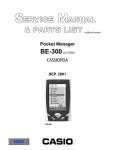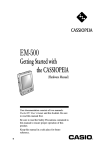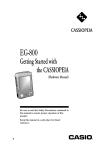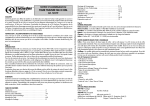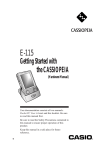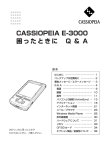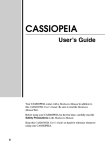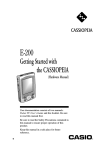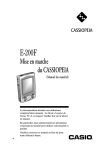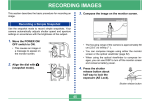Download Casio CASSIOPEIA Digital Camera User Manual
Transcript
BE-300 Getting Started with the CASSIOPEIA (Hardware Manual) User documentation consists of two manuals: CASSIOPEIA User’s Guide and this booklet. Be sure to read this manual first. Be sure to read the Safety Precautions contained in this manual to ensure proper operation of this product. Keep this manual in a safe place for future reference. E • Microsoft, Outlook, Windows, Windows NT and the Windows logo are either registered trademarks or trademarks of Microsoft Corporation in the United States and/or other countries. • Pentium is a registered trademark of Intel Corporation. • CompactFlash is a registered trademark of SanDisk Corporation. • All other product and company names mentioned herein may be the trademarks of their respective owners. • Data can be uploaded from this unit to a computer for storage on a hard disk, floppy diskette, or other storage medium. Be sure to make multiple copies of all important data to protect against its accidental loss. • CASIO COMPUTER CO., LTD. assumes no responsibility for any damage or loss resulting from the use of this manual. • CASIO COMPUTER CO., LTD. assumes no responsibility for any loss or claims by third parties that may arise through the use of this product. • CASIO COMPUTER CO., LTD. assumes no responsibility for any damage or loss caused by deletion of data as a result of malfunction, repairs, or battery replacement. Be sure to back up all important data on other media to protect against its loss. • The contents of this manual are subject to change without notice. • No part of this manual may be reproduced in any form without the express written consent of the manufacturer. • Specifications, peripherals, and other items can change suddenly to meet market needs. Such changes can cause the contents of this manual to become inaccurate. 2 Safety Precautions Congratulations upon your selection of the CASSIOPEIA. Be sure to read the following Safety Precautions before trying to use it for the first time. Note All mentions of “the unit” in the following precautions refer to the CASSIOPEIA. Markings and Symbols The following are the meanings of the markings and symbols used in these Safety Precautions. Danger This symbol indicates information that, if ignored or applied incorrectly, creates the danger of death or serious personal injury. Warning This symbol indicates information that, if ignored or applied incorrectly, creates the possibility of death or serious personal injury. Caution This symbol indicates information that, if ignored or applied incorrectly, creates the possibility of personal injury or property damage. • A diagonal line indicates something you should not do. The symbol shown here indicates you should not try to take the unit apart. • A black circle indicates something you should do. The symbol shown here indicates you should unplug the unit from the wall outlet. Health Precautions Warning • Long continuous use of the unit when you are tired is not good for your health, and should be avoided. Caution • Be sure to allow for adequate rest when using the unit for long periods. As a general rule, you should allow for 10 to 15 minutes of rest per hour. 3 Precautions During Use Warning Abnormal Conditions • Continued use of the unit while it is emitting smoke or strange odor creates the danger of fire and electrical shock. Immediately turn off power, unplug the AC adapter from the wall outlet, remove batteries, and contact your original dealer or an authorized CASIO service provider to request servicing. Water and Foreign Matter • Should any foreign matter (metal, water or other liquid) ever get into the unit, immediately turn off power, unplug the AC adapter from the wall outlet, remove batteries, and contact your original dealer or an authorized CASIO service provider to request servicing. Dropping and Damage • Should the unit ever fall or otherwise become damaged, unplug the AC adapter from the power outlet, remove batteries, and contact your original dealer or an authorized CASIO service provider. Continued use creates the danger of fire and electrical shock. Disassembly • Never try to take the unit apart or modify it in any way. Doing so creates the danger of fire and electrical shock. Handling the Stylus • Take care when using the stylus to avoid accidentally injuring your eyes or the eyes of other. Careless use of the stylus creates the risk of loss of sight or eye damage. 4 Caution Memory Protection • Be sure to keep separate copies of all important data by saving it on a computer hard disk or other medium. Note that all data stored in unit memory is deleted whenever batteries go dead. Memory contents can also become lost or corrupted due to malfunction and repair of the unit. Location • Do not locate the unit in an area subjected to large amounts of humidity or dust. Doing so can create the danger of fire and electrical shock. • Keep the unit away from food preparation area, stoves, and anywhere else it might be exposed to oil smoke or steam. Such conditions can create the danger of fire and electrical shock. Avoid unstable surfaces. • Never place the unit on an unstable surface, on a high shelf, or in any other unstable location. Doing so can create the danger of the unit falling and causing personal injury. Built-in Battery Pack Warning • Always leave built-in battery pack replacement up to an authorized service technician. Attempting to replace the battery pack yourself creates the risk of fire, personal injury, and other problems. 5 AC Adapter Warning • Never use a voltage that is different from that for which the AC adapter is rated. Also, do not plug the unit into a power outlet that is shared by other devices. Doing so creates the danger of fire and electrical shock. • Never modify the power cord or excessively bend, twist, or pull it. Doing so creates the danger of fire and electrical shock. • Do not allow the power cord to become damaged. Do not place heavy objects on the power cord or expose it to heat. A damaged power cord creates the danger of fire and electrical shock. • Never touch the AC adapter while your hands are wet. Doing so creates the danger of electrical shock. • Should the power cord ever become seriously damaged (internal wiring exposed or shorted), contact your original dealer or an authorized CASIO service provider to request servicing. Continued use of a seriously damaged power cord creates the danger of fire and electrical shock. • Use only the AC adapter specified for this unit. Use of another type of AC adapter can damage the battery pack and create the danger of fire and personal injury. Caution • Unplug the AC adapter from the wall outlet whenever leaving the unit unattended for long periods. • At least once a year, unplug the AC adapter from the power outlet and clean the area around the prongs of the plug. Dust build up around the prongs can create the danger of fire. • Be sure to unplug the AC adapter from the wall outlet before attempting to move the unit to another location. • Be sure to grasp the AC adapter when unplugging it from a wall outlet. Pulling on the power cord can damage it, and create the danger of fire and electrical shock. • Keep the power cord away from stoves and other sources of heat. Heat can melt the insulation of the power cord and create the danger of fire and electrical shock. 6 Display Screen Precautions Caution • Never apply strong pressure to the LCD screen or subject it to strong impact. Doing so can cause the LCD panel glass to crack or break. • Should the LCD panel glass ever crack or break, never touch the liquid inside of the panel. LCD liquid can lead to skin irritation. • Should LCD panel liquid ever get into your mouth, gargle with water and contact your physician immediately. • Should LCD panel liquid ever get into your eyes or onto your skin, flush the exposed area with clean water for at least 15 minutes, and then contact your physician. 7 Operating Precautions The CASSIOPEIA is a precision digital instrument. Incorrect operation and rough handling can cause data storage problems and other malfunction. Be sure to read the following precautions to ensure proper operation. • Charge the battery pack as soon as possible when its power goes low. Though memory data that is already saved is retained in flash memory even when the battery pack goes dead, some memory data may be lost if battery pack power drops below a certain level before or during automatic backup of data to flash memory. • The built-in battery pack can lose its ability to recharge if you do not charge it for a long time (about one month). Be sure to charge the battery pack periodically. • Use the CASSIOPEIA under the conditions listed below. • Temperature: 0°C to 40°C (32°F to 104°F) • No condensation Conditions other than those above can cause malfunction. • Avoid using the CASSIOPEIA in areas subjected to the following conditions. • Static electricity • Extreme heat or cold • High humidity • Sudden temperature changes • Large amounts of dust • If you drop the CASSIOPEIA and damage it, immediately turn off power and contact your original dealer or an authorized CASIO service provider. Never continue using a damaged unit. • Never place heavy objects on top of the CASSIOPEIA. • Never try to take the CASSIOPEIA apart. Doing so can cause malfunction. 8 • Never insert foreign objects into connectors, slots, or other openings. • Take care to avoid spilling water or drinks on the CASSIOPEIA. • Use only the stylus that comes with the CASSIOPEIA to press the [RESET] button. • Never use a pen, pencil, or other sharp writing implement. Doing so can scratch the touch screen and cause malfunction. • Never use thinner, benzene, cosmetics, or other volatile agents to clean the exterior of the CASSIOPEIA. Use only a dry soft cloth or a soft cloth moistened with a weak solution of water and mild neutral detergent. • Be sure to close the cover to protect the display panel of your CASSIOPEIA while carrying it. Important • Playing back movies, digital camera images, and audio files consumes large amounts of power and may cause the CASSIOPEIA to become warm to the touch. This is normal and does not indicate malfunction. • To avoid certain system problems, the power button is disabled (you cannot use it to turn off power) for about three seconds after you turn on power. 9 Built-in Battery Pack Service Life Though the built-in battery pack is rechargeable, it requires periodic replacement after it is used for a long time. If the message “Internal Battery Warning The internal battery is low. Continued use may result in loss of ability to store data. Charge the battery as soon as possible.” appears on the display when you turn on power or while you are using the CASSIOPEIA soon after you correctly charge the battery, it probably means that the built-in battery pack has reached the end of its normal service life. Do not remove the built-in battery pack yourself. Take the unit to your original dealer or an Authorized CASIO Service Provider to have it replaced. Note that you will be charged for battery pack replacement. • The normal rule of thumb for battery replacement is about once every two years (about 500 charges). Important • Never try to replace the battery yourself! Doing so creates the risk of fire, personal injury, or other serious problems. Disposing of Your CASSIOPEIA Be sure to remove the built-in battery pack from the CASSIOPEIA and dispose of it separately. Important • Perform the following steps to remove the built-in battery pack from your CASSIOPEIA only if you plan to dispose of your CASSIOPEIA and not use it any longer. Otherwise, you should never try to remove the built-in battery pack. 1. Remove the screws securing the battery pack compartment cover in place, and remove the cover. 10 2. Disconnect the battery pack connector and remove the battery pack. Connector 11 Contents Safety Precautions ............................................................................................ 3 Health Precautions .................................................................................................. 3 Precautions During Use .......................................................................................... 4 Built-in Battery Pack .............................................................................................. 5 AC Adapter ............................................................................................................. 6 Display Screen Precautions .................................................................................... 7 Operating Precautions ...................................................................................... 8 Built-in Battery Pack Service Life ........................................................................ 10 Disposing of Your CASSIOPEIA ................................................................... 10 Contents ........................................................................................................... 12 Terms and Symbols used in this manual ........................................................ 13 Getting Ready .................................................................................................. 14 Initial Setup .......................................................................................................... 14 Where to go for information... .............................................................................. 15 Operations ....................................................................................................... 16 General Guide ....................................................................................................... 16 Using the Stylus .................................................................................................... 17 Removing the cover .............................................................................................. 18 Recalibrating the Touch Screen ............................................................................ 18 Adjusting Display Contrast .................................................................................. 18 Adjusting Display Brightness ............................................................................... 19 Adjusting Auto Dimming Settings ....................................................................... 19 Using the Cradle ................................................................................................... 19 Changing the Cradle Configuration ............................................................... 20 To remove the CASSIOPEIA from the cradle ............................................... 21 Connecting the Cradle to a Computer ............................................................ 22 Using the CASSIOPEIA USB Cable .................................................................... 22 To connect to a computer using the CASSIOPEIA USB cable ...................... 23 Using the CASSIOPEIA Serial Cable .................................................................. 23 To connect to a computer using the CASSIOPEIA serial cable ..................... 24 Required System Configuration ........................................................................... 24 Using the AC Adapter ........................................................................................... 26 12 Using a CompactFlash Card ................................................................................. 27 To install a CompactFlash card ...................................................................... 28 Using a PC Card Unit ........................................................................................... 29 To connect your CASSIOPEIA to the PC Card Unit ..................................... 29 To remove the CASSIOPEIA from the PC Card Unit ................................... 30 About Modem Adapter (U.S. and Canada Only) .................................................. 30 Software Applications ........................................................................................... 30 User Maintenance ........................................................................................... 31 About the CASSIOPEIA’s built-in rechargeable battery ...................................... 31 Low Battery Warning and Data Storage ......................................................... 31 Charging the Battery Pack .............................................................................. 32 Resetting the CASSIOPEIA and Restoring Data ................................................. 34 To reset your CASSIOPEIA ........................................................................... 34 Restoring Data ...................................................................................................... 35 To restore data backed up to a computer ........................................................ 36 To restore data backed up to a storage card ................................................... 37 Restoring Factory Defaults ................................................................................... 39 To restore your CASSIOPEIA to its factory defaults ..................................... 39 Troubleshooting .............................................................................................. 41 Appendix .......................................................................................................... 43 Button Operations ................................................................................................. 43 Specifications ....................................................................................................... 44 Regulatory Information ........................................................................................ 45 Terms and Symbols used in this manual • The term “unit” in this manual refers to the CASSIOPEIA. • The symbol “Important ” indicates important information about a procedure that can result in problems if not performed correctly. Be sure to read such information carefully. 13 Getting Ready Initial Setup After you first unpack your CASSIOPEIA, perform the following initial setup procedure before using it for the first time. 1. Use the AC adapter to charge the battery pack. Important • Make sure you charge the battery pack before using your CASSIOPEIA for the first time. The CASSIOPEIA will not work until you charge its battery pack. 2. While holding down the [Power] button, use the stylus to press the [Reset] button. • This displays the initialization startup screen. After a short while, the touch screen calibration screen appears. 3. Follow the instructions that appear on the screen to set up your CASSIOPEIA. 4. The Top Menu appears on the screen after setup is complete. • You can later change the settings you make with this procedure if you want. See the separate CASSIOPEIA User’s Guide for more information. • See “Where to go for information...” on page 15 of this manual for information about where you should go to find out about the features and functions of your CASSIOPEIA. • Be sure to press the [Power] button to turn off power after you are finished using your CASSIOPEIA. Important • If the touch panel does not respond when you tap it or if nothing appears on the display, try performing a reset (page 34). 14 Where to go for information... Your CASSIOPEIA comes with two manuals: this Hardware Manual and a separate CASSIOPEIA User’s Guide. Be sure to read the contents of this Hardware Manual first. What should I do after reading this Hardware Manual? Read the CASSIOPEIA User’s Guide next to find out about the powerful software features and functions available on the CASSIOPEIA. What should I do if I run into problems? Check the troubleshooting guides on page 41 of this Hardware Manual and in the CASSIOPEIA User’s Guide. How can I connect my CASSIOPEIA to a computer? See page 22, 23, 24 of this Hardware Manual for details about how to connect and the type of computer you can connect to. How can I install the software on the CASSIOPEIA Applications CD-ROM? See the documentation contained on the CD-ROM. Important The optionally available modem adapter mentioned in this and the other manuals is intended for use in the U.S. and Canada only. 15 Operations General Guide Charge indicator (Amber) Lights amber when the battery pack is charging and goes off when full charge is achieved. Card slot Stylus Strap hole Touch screen Perform operations and input data by tapping and writing directly on the screen. Fixed Icons Tap an icon to launch the program assigned to it. See the CASSIOPEIA User’s Guide for details. Power button Turns power on and off. Top Menu button Press to display the Top Menu. See the CASSIOPEIA User’s Guide for details. Stereo headphone jack For connection of commercially available earphone/headphones (ø3.5mm). OK button Same as a computer’s ENTER key AC adapter terminal ESC button Same as a computer’s ESC key Cursor button Moves the cursor around the screen. Reset button Serial connector For connection of the cradle or the CASSIOPEIA USB cable. 16 Using the Stylus Data input and virtually all other operations are performed using a stylus, which is housed inside the stylus holder in the higher right corner of the CASSIOPEIA. The following defines the various operations that you can perform with the stylus. Tap ...................... Touch the screen once with the stylus to select a screen item. Drag .................... Hold the stylus on the screen and drag across the screen to select text and images. Drag in a list to select multiple items. Double-tap .......... Tap the touch screen twice to open an item. Important • Take care that you do not misplace or otherwise lose the stylus by always storing it in the stylus holder when you are not using it. • Take care to avoid breaking the tip of the stylus. • Use only the stylus that comes with the CASSIOPEIA, or some other stylus type instrument with a soft, blunt point to perform screen operations. Never use a pen, pencil, or other sharp writing implement. 17 Removing the cover Gently pull outwards on either of the cover hinges indicated by the arrows in the illustration until the hinge is free, and then remove the cover. Make sure you do not apply excessive force when removing the cover. Recalibrating the Touch Screen You should recalibrate the touch screen whenever touch screen response is bad, or when the operation performed is different from the operation you expected when tapping on the touch screen. To recalibrate the touch screen, press the [OK] button while holding down the [Power] button. Next, follow the instructions that appear on the screen. Adjusting Display Contrast Perform either of the following operations to adjust display contrast and make figures on the display darker or lighter. • Press the [Top Menu] button to display the Top Menu, and then tap Settings Brightness. Follow the instructions on your screen for adjusting the contrast. • You can also adjust contrast as follows. To do this: Do this: Make contrast darker Hold down the [Power] button as you press the up [Cursor] button Make contrast lighter Hold down the [Power] button as you press the down [Cursor] button 18 Adjusting Display Brightness Use the following operations to adjust display brightness to make it easier to read. 1. Press the [Top Menu] button to display the Top Menu, and then tap Settings Brightness. 2. On the dialog box that appears, tap the Brightness tab. 3. Follow the instructions that appear on the screen for adjusting the brightness. • You can also adjust brightness as follows. To do this: Do this: Make the screen brighter Hold down the [Power] button as you press the right [Cursor] button Make the screen dimmer Hold down the [Power] button as you press the left [Cursor] button Adjusting Auto Dimming Settings 1. Press the [Top Menu] button to display the Top Menu, and then tap Settings Brightness. 2. On the dialog box that appears, tap the Auto Dim tab. 3. Follow the instructions that appear on the screen to make auto dimming settings. • You can make separate auto dimming settings for internal power (battery power) and external power (AC adapter and optional large-capacity External Power Pack) by checking the appropriate check box. Using the Cradle The cradle provides quick and easy connection between your CASSIOPEIA and a computer. Your CASSIOPEIA can also be powered from an AC power source when it is placed on the cradle. • The battery pack charges while the CASSIOPEIA is on the cradle. See page 32 for more information. Important Before connecting your CASSIOPEIA to a computer, make sure you first install the PC Connect software on your computer. 19 Changing the Cradle Configuration The cradle has a back board which you can set to any one of the three positions shown in the illustration below. Use the position that suits the configuration of the CASSIOPEIA unit you are setting on the cradle. CASSIOPEIA + PC Card Unit CASSIOPEIA + External Power Pack CASSIOPEIA Only Important Make sure that CASSIOPEIA power is turned off before you place it onto or remove it from the cradle. Use the following procedure to place the unit onto the cradle. 1. Place the cradle on a desk or other flat level surface. 2. Turn off the CASSIOPEIA. 3. Remove the CASSIOPEIA’s serial connector cover to open it. 20 4. Orient the CASSIOPEIA in relation to the cradle as shown in the illustration below. 5. Taking care to align the serial connector on the bottom of the CASSIOPEIA with the connector on the cradle, lower the CASSIOPEIA into the cradle as shown in the illustration below. Important • Make sure the CASSIOPEIA lowers securely into the cradle as far as it can go. • While the CASSIOPEIA is on the cradle, take care to keep its serial connector cover in a safe place. Also, make sure you replace the serial connector cover when you remove the CASSIOPEIA from the cradle. To remove the CASSIOPEIA from the cradle Lift the CASSIOPEIA straight up from the cradle. 21 Connecting the Cradle to a Computer The cradle has a USB cable for connection to a computer. Connect the end of the cable to a USB port of the computer to which you want to connect. Important • See “Required System Configuration” on page 24 for details on the type of computer system required for use with the cradle. USB port • The above illustration is one example of possible connection configurations. The locations and layouts of USB ports vary from computer to computer. See the documentation that comes with your computer for full details on connecting cables to it. • Note that after connecting the cradle to your computer, you also need to make certain PC Connect software settings on your computer to enable data transfers. See the Quick Start Guide for information about how to install PC Connect, and PC Connect online help for information about how to use it. Using the CASSIOPEIA USB Cable You can use the CASSIOPEIA USB cable to connect the CASSIOPEIA directly to a computer. Important • See “Required System Configuration” on page 24 for the computer system that is required for direct USB connection. • The illustration below is just one possible connection configuration. The location and layout of USB ports vary from computer to computer. See the documentation that comes with your computer for full details on connecting cables to it. • You must have PC Connect software installed on your computer in order to exchange data with the CASSIOPEIA over a USB connection. See the Quick Start Guide for information about how to install PC Connect, and PC Connect online help for information about how to use it. 22 To connect to a computer using the CASSIOPEIA USB cable Important Before connecting your CASSIOPEIA to a computer, make sure you first install the PC Connect software on your computer. Use the steps below to connect the CASSIOPEIA to your computer when prompted to do so during the software installation procedure. 1. Plug the USB cable into the USB port of your computer. 2. Turn off your CASSIOPEIA. 3. Connect the other end of the USB cable to your CASSIOPEIA. USB port CASSIOPEIA USB cable Using the CASSIOPEIA Serial Cable You can use the CASSIOPEIA serial cable to connect the CASSIOPEIA directly to a computer. Important • Be sure to turn off the CASSIOPEIA and your computer before connecting the CASSIOPEIA. • See “Required System Configuration” on page 24 for the computer system that is required for direct serial connection. • The illustration below is just one possible connection configuration. The location and layout of serial ports vary from computer to computer. See the documentation that comes with your computer for full details on connecting cables to it. • You must have PC Connect software installed on your computer in order to exchange data with the CASSIOPEIA over a serial connection. See the Quick Start Guide for information about how to install PC Connect, and PC Connect online help for information about how to use it. 23 To connect to a computer using the CASSIOPEIA serial cable Important Before connecting your CASSIOPEIA to a computer, make sure you first install the PC Connect software on your computer. Use the steps below to connect the CASSIOPEIA to your computer when prompted to do so during the software installation procedure. 1. Plug the serial cable into the serial port of your computer. 2. Turn off your CASSIOPEIA. 3. Connect the other end of the serial cable to your CASSIOPEIA. Serial port CASSIOPEIA Serial cable Required System Configuration The minimum system configuration required for running PC Connect software is described below. Minimum System Requirements for PC Connect • Microsoft® Windows® 2000 Professional Service Pack 2, Microsoft Windows NT® Workstation 4.0 with Service Pack 6a, Microsoft Windows Millennium Edition (Windows Me), Microsoft Windows 98, Microsoft Windows 95 OSR2. (U.S. version) • Desktop computer with a Pentium® processor for Windows NT (166 MHz required for Windows 2000) • Desktop computer with a Pentium processor for Windows Me (150 MHz required for Windows Me) • Desktop computer with a 486/66 DX or higher processor (Pentium P90 recommended) for Windows 95/98 24 • 16 MB of memory for Windows 95/98 (more memory will give improved performance) or Windows NT Workstation 4.0 (32 MB recommended for Windows NT, 64 MB recommended for Windows 2000), 32 MB of memory for Windows Me • Hard disk drive with 30 MB of available hard disk space (actual requirements will vary based on selection of features and user’s current system configuration) • USB port (available for Windows 98, Windows Me or Windows 2000 only), Available 9 pin communications port with baud rate 115200bps (optional cable required). Proper operation may not be possible with certain hardware configurations. • CD-ROM drive • VGA graphics card or compatible video graphics adapter with 256 color or higher • Keyboard • Microsoft Mouse or compatible pointing device Note • CASSIOPEIA Calendar, Contacts, Tasks, and Mail data can be synchronized with Microsoft Outlook® 97/98/2000. However, note that the minimum system requirements to run Microsoft Outlook® 97/98/2000 differ from those noted above. • Different minimum system requirements are required when using the applications included on the CASSIOPEIA CD-ROM. See the documentation contained on the CD-ROM for full details. • Certain computer hardware and/or software configurations may not allow PC Connect to run properly. Important • When installing PC Connect software on a computer, check to make sure that the specified COM port number correctly indicates the serial port to which the cradle is connected. • Some laptop and sub-compact computers with built-in infrared ports and modems are initially configured so the COM port is not always used as a serial port. In such a case, you must change the setting so the COM port is always used as a serial port. See the documentation that comes with your computer for full details on COM port numbers and settings. 25 Using the AC Adapter You can use the AC adapter to directly power the CASSIOPEIA or to supply power through the cradle. The battery pack charges while the CASSIOPEIA is directly connected to a power source by the AC adapter or while it is on the cradle. See page 32 for more information. ■ Direct Connection ■ Cradle Connection Warning Use only the AC adapter that is specified for this unit. Use of another type of AC adapter creates the danger of malfunction and bursting of the battery pack. Important • Power also will not turn on if the battery pack is dead. • Long term use of the AC adapter can cause it to become warm to the touch. This is normal and does not indicate malfunction. • Be sure to unplug the AC adapter from the power outlet whenever you are not using it. • The AC adapter is designed for indoor use only. Do not use it outdoors. 26 Using a CompactFlash Card Your CASSIOPEIA supports Type I and Type II CompactFlash Cards (3.3V). The following describes the types of CompactFlash card you can use with your CASSIOPEIA. Storage Card A storage card functions the same as the CASSIOPEIA’s data storage memory. You can use a storage card to store the various files created by your CASSIOPEIA, and you can even install programs on a storage card. Data you store on a storage card is retained even when you remove the card from your CASSIOPEIA, which means a card can be used to port data between your CASSIOPEIA and computer or other device, or to keep backup copies of important data. Digital Camera Card The CASIO Digital Camera Card (JK-710DC) in combination with the Photo Viewer application on the CASSIOPEIA CD-ROM provides you with still image recording capabilities. See the CASSIOPEIA User’s Guide for more information about using Photo Viewer. Modem Card A modem card lets you connect to a telephone line (standard household modular jack, public telephone with modular jack, etc.) for modem data communications. Wireless Modem Card With a wireless modem card, you can perform mobile data communication without a wire connection to a telephone circuit. Important • Gently but firmly slide the card into place as far as it will go, but do not force it. Forcing a card can damage connectors. If you have problems inserting a card, pull it out and check to make sure it is oriented correctly. • We strongly recommend that you store all unsaved data you are inputting or editing before performing this procedure. • Sometimes, your CASSIOPEIA may not be able to detect a CompactFlash card. This is indicated when a program on the card does not start up normally. When this happens, remove the card, reinsert it, and then press the CASSIOPEIA [Reset] button. • Your CASSIOPEIA supports 3.3V CompactFlash cards only. 5.0V cards are not supported. 27 Important • Your CASSIOPEIA comes with a dummy card installed in its card slot. Be sure to remove the dummy card before trying to insert another card. • An empty card slot creates the risk of damage to the slot when pressure is applied to the CASSIOPEIA. Always insert the dummy card when you are using the CASSIOPEIA without a card. To install a CompactFlash card 1. Make sure your CASSIOPEIA is turned off. • Press the [Power] button to turn off power. 2. If there is a dummy card or another CF card in the slot, remove it. 3. Slide the card you want to use into the card slot. • Make sure the top of the card is facing towards the top of the CASSIOPEIA unit. A card that is not oriented correctly will not slide all the way into the slot. Top Bottom Carefully slide the card into the slot as far as it will go. 28 Using a PC Card Unit Connecting your CASSIOPEIA to an optional PC Card Unit (JK-865PU) makes it possible for you to use PCMCIA card type PC cards with your CASSIOPEIA. Important • The PC Card Unit has a built-in lithium battery that provides power to the PC card. It comes with an AC adapter that can be used to charge its built-in battery or to connect to a wall outlet for power supply. See the user documentation that comes with the PC Card Unit for details about the built-in battery and the AC adapter. To connect your CASSIOPEIA to the PC Card Unit 1. Make sure your CASSIOPEIA is turned off. • Press the [Power] button to turn off power. 2. If there is already a card in the slot, remove it. 3. Slide your CASSIOPEIA onto the PC Card Unit as shown in the illustration below. • Make sure the CompactFlash card connector of the PC Card Unit slides into the CASSIOPEIA card slot as far as it will go. This causes the CASSIOPEIA to lock in place on the PC Card Unit. 29 To remove the CASSIOPEIA from the PC Card Unit 1. Make sure your CASSIOPEIA is turned off. • Press the [Power] button to turn off power. 2. Pulling on your CASSIOPEIA in the direction indicated by the arrow in the illustration, remove it from the PC Card Unit. About Modem Adapter (U.S. and Canada Only) Use of a modem adapter lets you use your CASSIOPEIA to access the Internet over an analog dial-up connection. See the documentation that comes with the modem card for information about how to use it. Important Check to make sure that the battery pack is charged before using the modem adapter. Low battery power can cause sudden interruption of communications, unstable communications, and loss of data. Software Applications Your CASSIOPEIA comes with a CASSIOPEIA CD-ROM that contains a number of useful applications. Note that you must install the applications you need from the CDROM before you can use them. See the CASSIOPEIA User’s Guide for details on using the software applications. Important • Whenever purchasing software applications, always double-check to make sure that it is compatible with the CASSIOPEIA BE-300. 30 User Maintenance About the CASSIOPEIA’s built-in rechargeable battery Note the following precautions concerning the CASSIOPEIA’s rechargeable battery. • We recommend that you use the Power dialog box to keep informed about the current levels of your battery. See the separate CASSIOPEIA User’s Guide for more information about this dialog box. • Icons appear along the bottom of the screen to let you know when battery power is low. See the separate CASSIOPEIA User’s Guide for more information about these icons. Low Battery Warning and Data Storage • The following message appears whenever battery power drops below a certain level. Recharge the battery as soon as possible after the following message appears. “Internal Battery Warning The internal battery is low. Continued use may result in loss of ability to store data. Charge the battery as soon as possible.” • Whenever the low battery warning message appears, especially if it appears right after you turn on power, follow the instructions that appear on the screen and recharge the battery as soon as possible. Continued use under low battery power can cause unstable performance of your CASSIOPEIA. If unit power turns off due to insufficient power, the following warning message appears on the display the next time you turn on unit power. “Warning The system has shut down without warning to protect memory contents, due to high electrical current consumption by hardware...” If unit power turns off due to sudden power drain by a CompactFlash card, the following warning message appears on the display the next time you turn on unit power. “Warning The system has shut down without waring to protect memory contents, due to high electrical current consumption by the card...” 31 Important Be sure to observe the following important battery handling precautions. Failure to do so can cause batteries to leak, resulting in damage to surrounding items and create the danger of fire and electrical shock. • Charge the battery pack in an area where the temperature is between 10°C (50°F) and 35°C (95°F). Charging in areas that are very cold or exposed to direct sunlight can cause deterioration and leaking of the battery pack. • To avoid deterioration and leaking, the battery pack is designed to discharge even when you do not use the CASSIOPEIA. Be sure to recharge the battery pack at least once a month, regardless of how much you use the CASSIOPEIA during that time. Charging the Battery Pack Attach the AC adapter to the cradle and place the CASSIOPEIA onto the cradle. • Charging starts automatically as soon as you place the CASSIOPEIA onto the cradle. • The charge indicator is amber while charging is in progress, and goes off when charging is complete. • It takes about three or four hours to reach full charge. • You can use your CASSIOPEIA while the battery pack is charging. Important • Do not use the CASSIOPEIA while it is charging for the first time after you purchase it. • If the battery does not achieve full charge after the normal charge time, unplug the AC adapter from the cradle to stop charging. 32 Remove the CASSIOPEIA from the cradle after charging is complete. The following illustration shows how to connect the AC adapter directly to the CASSIOPEIA for charging. • Charging starts automatically as soon as you attach the AC adapter to the CASSIOPEIA. • Direct connection charging conditions are the same as those described for cradle charging above. 33 Resetting the CASSIOPEIA and Restoring Data What does resetting the CASSIOPEIA do? Resetting your CASSIOPEIA is the same as restarting your computer. Performing a reset causes any data you are working on but have not saved yet to be lost, but data saved in memory and other settings are basically left unchanged. You should perform the reset operation whenever your CASSIOPEIA behaves abnormally due to operational error or some other problem. The reset operation is required in the following cases. • When there is no response when you tap the screen or press a button • When the icon that indicates some operation is in progress continues to rotate on the screen for a long time Important • Check to make sure the button. icon is not in the system tray before you press the reset • Performing the reset operation causes all user files and folders that are not contained in the My Device\Nand Disk folder to be deleted. To keep a file or folder from being deleted by the reset operation, store it in the My Device\Nand Disk folder or on a storage card. • Though saved data is normally not lost when you perform a reset operation, abnormal data in memory can cause all saved data to be cleared. Because of this, you should always back up data to a storage card whenever possible before performing a reset operation. To reset your CASSIOPEIA 1. Turn on your CASSIOPEIA. 2. Use the stylus to press the [Reset] button. 3. The message “Starting...” appears on the display to let you know that the reset operation is starting. 34 • The Top Menu should appear on the display after a short while. Since this procedure does not affect data and settings stored in memory, you can now continue using the CASSIOPEIA. What to do if resetting does not solve the problem Perform the following steps if resetting the CASSIOPEIA does not restore normal operation. 1. While holding down the [Power] button, use the stylus to press the [Reset] button. • This displays the initialization startup screen. 2. The message “Starting...” appears on the display to let you know that the reset operation is starting. • The Top Menu should appear on the display after a short while. Since this procedure does not affect data and settings stored in memory, you can now continue using the CASSIOPEIA. Important • If you continue to have problems after performing the above steps, you need to perform the procedure under “Restoring Data”. Restoring Data If your CASSIOPEIA does not operate normally and the reset procedures under “To reset your CASSIOPEIA” on page 34 and “What to do if resetting does not solve the problem” on page 35 do not correct the problem, you should be able to restore normal operation using any one of the following procedures. • Use PC Connect to restore CASSIOPEIA data you have backed up on your computer. • Use data you backed up to a memory card to restore CASSIOPEIA data. • Use the bundled CD-ROM to restore the CASSIOPEIA to its initial factory defaults (page 39). Important • All of the above methods cause data currently stored in CASSIOPEIA memory to be deleted. • If normal operation is not restored after you perform any of the above procedures, contact your original dealer or an authorized CASIO service provider. 35 To restore data backed up to a computer 1. Connect the AC adapter to the CASSIOPEIA. 2. Press the [Power] button. 3. While holding down the [OK] button, use the stylus to press the [Reset] button. • This enters the Safe Mode. 4. Tap the [OK] button. • This displays the touch screen calibration screen. Follow the instructions on the display to calibrate the touch screen. • The following screen appears after you finish touch screen calibration. 5. Start up your computer (which should have PC Connect installed on it), start up PC Connect, and establish a connection between the computer and your CASSIOPEIA. 6. Tap [PC Connection]. • This establishes a connection between your CASSIOPEIA and computer. In response to the dialog box that appears to ask if you want to start up by restoring backup data, tap [OK]. • The following steps are performed in PC Connect on your computer. 36 7 On the PC Connect initial screen, select [Restore] on the [Tool] menu. • This displays the [Restore] dialog box. 8. Select the back up file you want to restore, and then click [OK]. • This starts restoration, which is indicated by messages on the screens of your computer. • After restoration is complete, a message appears on your computer screen asking if you want to restart your CASSIOPEIA. 9. Click [OK]. • This restarts your CASSIOPEIA. 10.On your CASSIOPEIA, perform the steps under “What to do if resetting does not solve the problem” on page 35. MEMO • Pressing [ESC] in step 4 exits the above procedure and starts the normal reset procedure under “To reset your CASSIOPEIA” on page 34. • Press the [Power] button in step 4 of the above procedure turns off the CASSIOPEIA. You can then turn power back on and perform a normal reset. • If you do not do anything when the confirmation message appears in step 4 of the above procedure, your CASSIOPEIA will turn off automatically after about 30 seconds. You can then turn power back on and perform a normal reset. To restore data backed up to a storage card 1. Connect the AC adapter to the CASSIOPEIA. 2. Press the [Power] button. 3. While holding down the [OK] button, use the stylus to press the [Reset] button. • This enters the Safe Mode. 4. Tap the [OK] button. 37 • This displays the touch screen calibration screen. Follow the instructions on the display to calibrate the touch screen. • The following screen appears after you finish touch screen calibration. 5. Insert the storage card that contains the backed up data into the CASSIOPEIA’s card slot. 6. Tap [Storage Card]. • This starts the backup operation. 7. Tap [Restore]. • This displays the dialog box shown below. If you protected data with a password when backing it up, input the password here. If you did not protect the data with a password, perform the following step without inputting anything. 38 8. Tap [Yes] to start the restore operation. 9. In response to the “Restore complete” message that appears after restoration is complete, tap [OK]. • This automatically resets the CASSIOPEIA, so wait a few moments until it starts up. Restoring Factory Defaults You can use the procedure below to restore the CASSIOPEIA to its factory defaults in the following cases. • When the procedures under “To reset your CASSIOPEIA” on page 34 and “What to do if resetting does not solve the problem” on page 35 do not restore normal operation • When you forget your CASSIOPEIA’s password. • When you want to clear all CASSIOPEIA data and settings before selling it or transferring it to another person To restore your CASSIOPEIA to its factory defaults 1. Connect the AC adapter to the CASSIOPEIA. 2. Press the [Power] button. 3. While holding down the [OK] button, use the stylus to press the [Reset] button. • This enters the Safe Mode. 4. Tap the [OK] button. • This displays the touch screen calibration screen. Follow the instructions on the display to calibrate the touch screen. • The following screen appears after you finish touch screen calibration. 39 5. Start up your computer (which should have PC Connect installed on it), start up PC Connect, and establish a connection between the computer and your CASSIOPEIA. 6. Tap [PC Connection]. • This establishes a connection between your CASSIOPEIA and computer. In response to the dialog box that appears to ask if you want to start up by restoring backup data, tap [OK]. • The following steps are performed in PC Connect on your computer. 7. Place the CD-ROM that came bundled with your CASSIOPEIA into your computer’s CD-ROM drive. 8. On the PC Connect initial screen, select [Restore] on the [Tool] menu. • This displays the [Restore] dialog box. 9. Select the [Restore factory defaults], and then click [OK]. • This starts restoration, which is indicated by messages on the screens of your CASSIOPEIA and computer. • After restoration is complete, a message appears on your computer screen asking if you want to restart your CASSIOPEIA. 10. Click [OK]. • This restarts your CASSIOPEIA. • On your CASSIOPEIA, perform the steps under “What to do if resetting does not solve the problem” on page 35. 40 Troubleshooting Before assuming malfunction and contacting your service provider when experiencing operational problems, be sure to check the following information as well as the troubleshooting section of the CASSIOPEIA User’s Guide first. Nothing happens when the [Power] button is pressed. Possible Cause Recommended Action Page The battery is weak. Charge the battery pack. 32 Internal malfunction Reset the unit. 34 Operation is disabled when the AC adapter is connected. Possible Cause Recommended Action Page The battery is weak. Charge the battery pack. 32 The unit is not mounted on the cradle correctly. Mount the unit on the cradle correctly. 20 The battery pack life is very short after each charge. Recommended Action Possible Cause Battery pack is damaged or has reached the end of its service life. Contact your original dealer or an authorized CASIO service provider. Page – Nothing happens when the touch screen is touched. Possible Cause Recommended Action Page The touch screen is out of calibration. Recalibrate the touch screen. 18 Static electricity or some other problem has caused the touch screen to malfunction. Reset the unit. 34 The touch screen is damaged. Contact your original dealer or an authorized CASIO service provider. – 41 The screen is locked up. Possible Cause Internal malfunction Recommended Action Reset the unit. Page 34 A message about a data error is on the screen. Possible Cause Internal malfunction Recommended Action Follow the instructions that appear on the screen. Page – Some other warning message is on the screen. Possible Cause Internal malfunction Recommended Action Follow the instructions that appear on the screen. If the reset operation does not restore normal operation, perform the steps under “What to do if resetting does not solve the problem” on page 35. 42 Page – Appendix Button Operations The following shows the function of each button under various conditions. Unit Power Off [Power] Button ........................... Turns on power. Unit Power On [Power] Button + [OK] Button ............................ Launches the touch screen calibration procedure. [Power] Button + Cursor up ................................ Makes contrast darker. [Power] Button + Cursor down ........................... Makes contrast lighter. [Power] Button + Cursor right ............................. Increases brightness. [Power] Button + Cursor left ............................... Decreases brightness. 43 Specifications Model: Display: BE-300 240 × 320 dots STN Color LCD (32,768 colors) CPU: VR4131 Memory: ROM 16MB Flash ROM RAM 16MB Interfaces: Serial: RS-232C, 115.2 kbps max. USB (Client) Card Slot: CompactFlash card, 3.3V Type I/TypeII Headphone jack: ø 3.5 mm stereo output Accepts monaural earphone, stereo earphones/headphones Power Supply Rechargeable battery (Lithium-Ion battery) AC adapter (AD-C59200) Power Consumption: 3.0W Approximate Battery Life (Normal Temperature) (Actual time may be shorter due to conditions when charging.) 1 week: Based on normal use 4 hours: Continuous input and data display at a ratio of 1:10, with screen brightness at lowest possible level. • Even when the unit is turned off, small amounts of power are required to retain memory contents, etc. This can cause batteries to go dead even when you do not use the unit. • The actual amount of operation time that can be expected from batteries depends on operating conditions, settings, and other variables. Approximate Charge Time (Normal Temperature) 3 to 4 hours: Charge time is longer for the first charges after purchasing the unit or installing a new battery pack. Operating Temperature: 0°C to 40°C (32°F to 104°F) Charging Temperature: 10°C to 35°C (50°F to 95°F) Dimensions: 17.9 H × 76.0 W × 121.0 D mm (3/4"H × 3"W × 4 3/4"D) (Excluding cover and projections.) Weight: Approximately 170 g (6.0 oz) (Including cover.) Approximately 158 g (5.6 oz) (Excluding cover.) 44 Regulatory Information GUIDELINES LAID DOWN BY FCC RULES FOR USE OF THIS UNIT IN THE U.S.A. (not applicable to other areas). NOTICE This equipment has been tested and found to comply with the limits for a Class B digital device, pursuant to Part 15 of the FCC Rules. These limits are designed to provide reasonable protection against harmful interference in a residential installation. This equipment generates, uses and can radiate radio frequency energy and, if not installed and used in accordance with the instructions, may cause harmful interference to radio communications. However, there is no guarantee that interference will not occur in a particular installation. If this equipment does cause harmful interference to radio or television reception, which can be determined by turning the equipment off and on, the user is encouraged to try to correct the interference by one or more of the following measures: • Reorient or relocate the receiving antenna. • Increase the separation between the equipment and receiver. • Connect the equipment into an outlet on a circuit different from that to which the receiver is connected. • Consult the dealer or an experienced radio/TV technician for help. FCC WARNING Changes or modifications not expressly approved by the party responsible for compliance could void the user's authority to operate the equipment. Proper connectors must be used for connection to host computer and/or peripherals in order to meet FCC emission limits. Connector ...................... BE-300 unit to Cradle Connector cable ............. BE-300 unit to computer Declaration of Conformity Model Number: BE-300 Trade Name: CASIO COMPUTER CO., LTD. Responsible party: CASIO, INC. Address: 570 MT. PLEASANT AVENUE, DOVER, NEW JERSEY 07801 Telephone number: 973-361-5400 This device complies with Part 15 of the FCC Rules, Operation is subject to the following two conditions: (1) This device may not cause harmful interference, and (2) this device must accept any interference received, including interference that may cause undesired operation. Tested To Comply With FCC Standards FOR HOME OR OFFICE USE 45 CASIO ELECTRONICS CO., LTD. Unit 6, 1000 North Circular Road London NW2 7JD, U.K. CASIO COMPUTER CO., LTD. 6-2, Hon-machi 1-chome Shibuya-ku, Tokyo 151-8543, Japan PN411573-001 MO0108-A















































